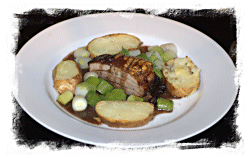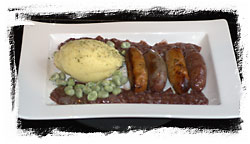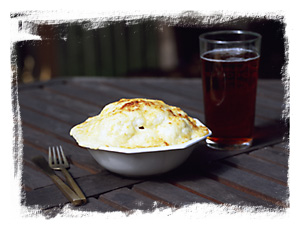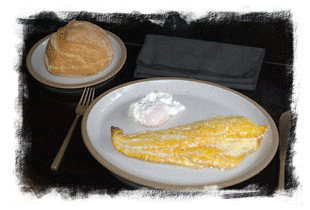
Traditional English food
The word "pasty" comes from "pasta". Originally made with hard pastry as a container, rather than something to be eaten, when it was taken down tin mines or out into the fields. The pastry forms an sealed pastry envelope. Originally containing almost anything the Cornish Pasty now contains seasoned chopped root vegetables and minced beef. The Bedfordshire Clanger is (or was) a variation on the same idea using a suet crust.
Lamb and black pudding slow cooked in a covered casserole with sliced potatoes layered on top.
Lancashire Hotpot recipe
Fish (cod, haddock, huss, plaice) deep fried in flour batter with chips dressed in malt vinegar.
In the north often served with "mushy peas" (mashed processed peas). Not normally home cooked but bought at a fish and chip shop ("chippie" in north of England) to eat on premises or as a "take away" or as US would say "to go".
A lamb pie cooked in a casserole with a layer of mashed potato acting as a lid.Cottage pie is the beef version
Shepherds' Pie Recipe
 Sandwiches
- slang "butties" or "sarnies"
Sandwiches
- slang "butties" or "sarnies"
Said to have been invented by the 4th Earl of Sandwich so that he could eat conveniently at the gaming table. The first printed reference to it is from 1762. The cucumber sandwich is probably regarded as the typically english sandwich although it is not very common.
A batter of egg, flour and milk cooked in beef dripping. Now used as an accompaniment to beef it was originally served with gravy before the main course to reduce the appetite.
"Toad in the hole" is a large Yorkshire pudding cooked with sausages embedded in it.
Steak and Oyster Pie
From the days when oysters were poor mans food used to bulk up meat dishes.
 Sausage
and Mash
Sausage
and Mash
"Bangers and mash" is probably currently (2004) the ubiquitous pub meal. Mashed potato, good quality sausages and onion gravy. There is no real way of knowing how good the sausages are without trying them, but as a general guide, packaged branded ones from major manufacturers tend to be poor while sellers featuring a range of innovative fillings (rather than just plain pork) are likely to be the best.
Modern British version
 Cauliflower
Cheese
Cauliflower
Cheese
Boil or steam a cauliflower until al dente (either whole or in florets). Melt butter and make a roux with white flour, add milk gradually until thick sauce obtained. Add mustard powder and freshly ground white pepper. Stir in grated or crumbled hard cheese such as cheddar until it melts. Do not overcook. Drain cauliflower carefully, place in bowls that will be safe under the grill and coat with the cheese sauce, sprinkle with more cheese and brown under grill.
A Cornish pilchard pie with the heads sticking out of the pastry.
A short crust pastry tart filled with jam, ground almonds and beaten egg.
Drop scones served with strawberry jam and clotted cream, served with a pot of tea and extra hot water to top it up.
Lightly seasoned Morecombe Bay shrimps in butter.
Melton Mowbray raised pork pies are made from lard pastry, filled with chopped pork, topped off with pork jelly. A little anchovy sauce is added.
Suet is fat found around the kidneys of cattle, used to make a kind of soft pastry filled with steak and kidney or as a dessert with something sweet like golden syrup."Spotted Dick and Custard" is a rather alarmingly named sweet variety.
Probably the nicest savoury form is a bacon and sage roll.
Left over cabbage and mashed potato made into patties and shallow fried.
Pie and Mash shops are a traditional London speciality. They serve jellied eels, meat pies and mashed potato with a "liquor" which is a type of parsley sauce.
<Goddards pie shop website>
English Cooked Breakfast
The "Full English Breakfast" is rarely eaten at home but is looked forward to when staying in hotels. Fried bacon, sausages, fried egg, black pudding, fried tomatoes, fried bread and baked beans followed by toast and marmalade with a pot of tea.
 Smoked
Haddock and poached egg
Smoked
Haddock and poached egg
Traditionally dyed a garish yellow nowadays increasingly eaten undyed.
A split and smoked herring used as an alternative to the "cooked breakfast" above.
Probably more Scottish than English.
 Food
in England - Dorothy Hartley
Food
in England - Dorothy Hartley
First published in 1954, full of recipes, anecdotes and information on how to cook in the days before meat came in a plastic wrapper. English cooking from the earliest times.
"A classic book without a
worthy successor - a must for any keen English cook" Delia Smith.
"A true source-book, a labour
of love...a plum-pudding of a book - stuffed with all manner of delicious
things, and all the better for the keeping" Elisabeth Luard
Some chapter headings:-
English Kitchens - Fuel
& Fireplaces - Meat - Poultry and Game - Eggs - Mediaeval Feast and
Famine - Magic & Religion - Fish - Seaweed - Fungi - Elizabethan Households
- The New World - Salting and Drying - House & Garden in 1600 - Vegetables
- Coaching days - Fruit and Herbs - The Hafod - Dairy - Bread - Drinks
- Industrial revolution - Pies and Puddings, Pastries, Cakes.
![]()
![]()
Back
London walks homepage
Modern British cookery
books
Modern British
recipes